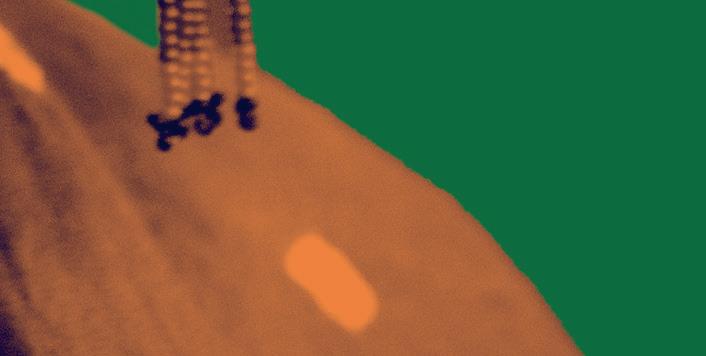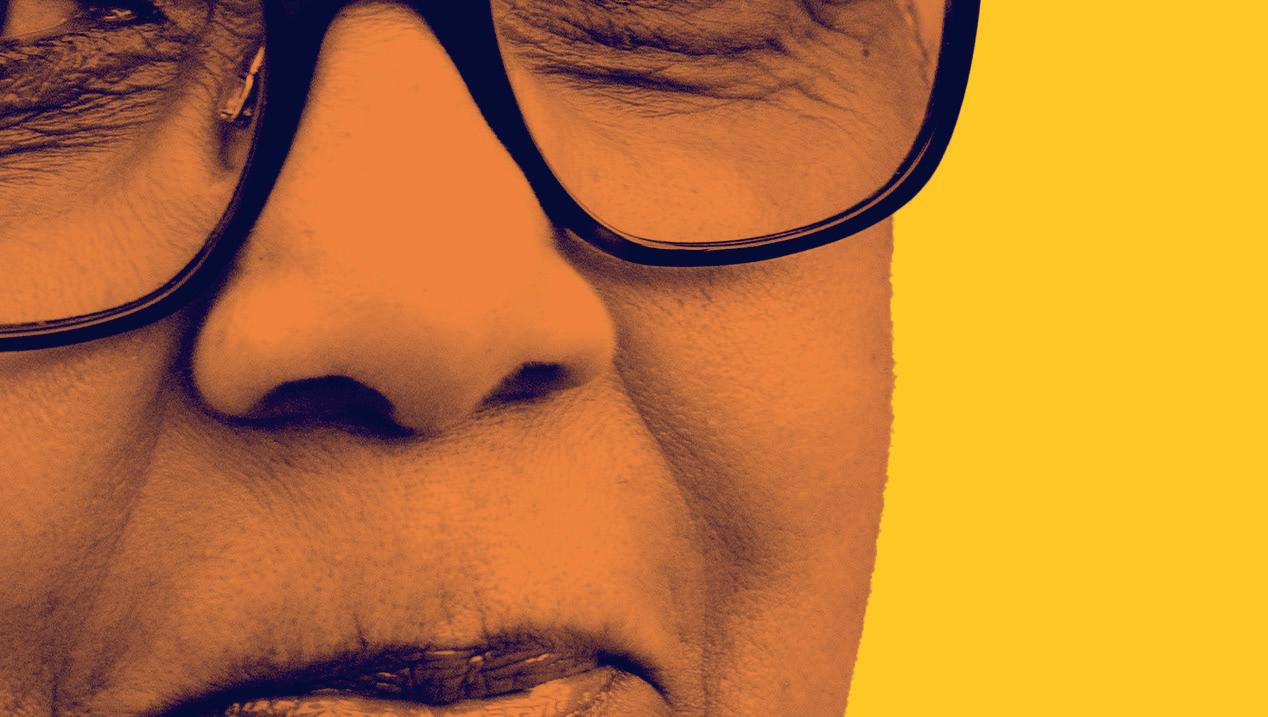
11 minute read
Radha D’Souza


Advertisement




In fourth grade, I told my mother I was going to study at a friend’s house. But instead, I secretly took a 45-minute bus ride to the big city. I, a small kid in a school uniform and a ponytail, spent my afternoon wandering around the bustling, noisy streets, full of pedestrians rushing to somewhere that seemed extremely important, crossing and dancing around each other’s paths. There were mixed sounds of conversations, laughter, and arguments, and the scent of the salty ocean mixed with car exhaust, perfumes, and body odours. I was hooked and kept sneaking out whenever I could. Only one bus ride away from me, a world bursting with mysteries to be explored.
Smart Cities Cities will always represent for me a ‘sum that is bigger than its part’, more than geographic and architectural landscapes that one can chart and visit, an intricate tapestry of histories, communities, today, urban environments quickly become a perfect petri dish for identifying, targeting, and implementing mass behaviours and trends. An
and stories. Cities are formed and can only be truly experienced by unmediated shared and intimate experiences, attitudes, and etiquettes. Such qualities can only be comprehended by unmediated engagement.
With the incredible real-time computational and spatial technological abilities we hone ideal condition to champion the integration of digitally-infused urban systems to create Smart Cities, berating the innovation value that large-scale data analysis can produce such as its contribution to deploy eff ective policies and effi ciently respond to citizens’ needs.
This approach might be wellintentioned but echoes a narrow perspective of technological means as the core (and only) path for progress. Some automation paths can lead to experiential hell. Think about outsourcing customer service to automated bot systems and virtual assistants. Service bots might be generally effi cient, but they force users to communicate with algorithms that fail to provide a real sense of interpersonal attention or off er solutions for unique problems. At times, such mechanisms are deliberately designed to deter users from receiving hands-on assistance, such as discouraging users from terminating a service agreement or subscription. Imagine such ‘joy’ integrated into a city-wide environment.
Smart Cities propagate effi ciency, digital coherency, and information © Ruben Hamlink
Radha D’Souza Writer, critic, commentator & expert international law, development and confl ict
At DCFA, we talk about cities all the time – but what are the origins of the concept of the city? Radha D’Souza critically refl ects on urban life and lays the history of its existence along a lengthy timeline of imperialism, oppression and patriarchal thought.
Pakhuis de Zwijger’s programme Designing Cities for All focuses on the role of designers ‘in shaping and creating cities for and by everyone’1. Who are the designers that design cities, and what are designers designing when they design cities? Did modern humans have a blueprint, a model, or a drawing for the cities that they created? Or did men engage in other pursuits and passions, the by-products of which are the cities we see?
The first approach, about modelling cities, invites us to accept the cities as something we have inherited. With their factories, railroads, government offices, warehouses, slums, penthouses, theatres, art galleries and much else, cities are a clutter of certain types of human activities that are not primarily about urban design. As Robert E. Park (1864-1944) noted, founder of the Chicago School of Sociology and an early thinker on urbanisation: “[…] if the city is the world which man created, it is the world in which he is henceforth condemned to live. Thus, indirectly, and without any clear sense of the nature of his task, in making the city man has remade himself.”2
If ‘man’ is condemned to live in the cities they have created, as Park noted, the only thing that remains to be done is to attempt to govern them better to mitigate their worst effects. This approach relies on a conception of human will and human ingenuity. Urban designers are the expression of that will, which they must direct to the lived realities of the cities they have inherited.
From the urban planners with their emphasis on urban infrastructure provisions of the early twentieth century, to the post-war social ecology approaches that drew attention to human alienation in urban conglomerations, \
1 Project description of Designing Cities For All on Pakhuis de Zwijger’s website. 2 R.E. Park, On Social Control And Collective Behavior: Selected Papers. Edited By-Ralph H. Turner (1967) 3 In the Third World, we don’t replace this term with for instance ‘Global South’ – except, of course, the mainstream. We see it as a neoliberal term, promoted by Euro-American institutions, that blurs anti-colonial anti-imperialist histories.
to the Third World3 oriented habitat development of the UN Development Decades, to the eco cities and sustainable cities of the environment conscious era, to the smart cities of the neoliberal era, to the diverse and inclusive cities of the race and diversity conscious present – these DIY approaches have sought to respond to the transformations of cities, into ‘metropolitan’, ‘mega’ and ‘smart’ cities. These approaches have paid less attention to the invisible hands that make and unmake cities, that expand their scales, size and scope, that turn humans into migrating flocks that travel from city to city to survive, and in the process of making and unmaking cities, make and remake the people who live in them. The second question, about whether cities are by-products of men’s (and some women and non-binary people’s) pursuits and passions, leads us to ask whether cities can be designed at all – whether the city planners, urban architects and designers are in effect trying to ‘pick up the mess’, as it were, that is created by invisible forces beyond their aesthetic horizons. In the modern world, Adam Smith’s ‘invisible hand of the market’ and the will of the market replaces God’s hand and God’s will of the pre-modern era. Through their fickle and transient investment, industrial, financial and trading activities and movements, markets – including hierarchical and racialised labour markets – are constantly making and unmaking cities.
Can designers design cities without lifting the veil on the invisible hand of the markets that keeps throwing evermore problems at them to deal with? Must planners, architects and designers remain condemned cleaning up the mess that the city’s inhabitants are condemned to live in?
There are certain problems associated with modern cities that have remained more or less the same in their essential character for over three centuries. When modern cities were brought into existence by industrialisation, factory systems, commodity exchanges, banks, ports and docks and mercantile activities, this also brought into existence the slums and urban squalor, extreme wealth polarisation, human alienation and degradation manifesting as alcohol and drug addictions, tensions and conflicts between marginalised social groups that manifest as gang wars and ethnic tensions, and, from time to time, riots and epidemics, that continue to present new questions about ethics and aesthetics. Over three centuries, designers have sought to design more humane and liveable cities, and cities have defied them. Yet, city-building continues relentlessly and designers continue their efforts to humanise cities.
In 2008, the former Home, Finance and Law minister for India, P. Chidambaram, in a newspaper interview said that his vision for India was to see 85 percent of Indians live in cities.4 Already, around 36 percent of India’s population lives in cities. A quarter of those live in slums. Nearly 55 percent of Mumbai’s inhabitants live in slums. The slum population of India is larger than the population of Great Britain. And India is home to more than one-sixth of humanity. Is Chidambaram designing cities or is it the architects and designers?
Twelve years after Chidambaram unveiled his vision for India, an estimated half a million farmers in India encircled the borders of the capital New Delhi, where they protested for over a year against three farm laws that they feared would evict them from land and drive them to cities to seek work. The farmers at the very least were not enamoured by the cities or their designers. Since colonial times, they had seen millions of small and poor peasants thrown
4 Danish, ‘How do you plan to accommodate migrants, Mr Chidambaram?’ (25-01-2012)
off their lands to make way for cities; they had seen the urban poor leaving the cities seeking greener pastures in Europe, North America and elsewhere to survive, and they continued to watch images on television screens of the urban poor being beaten and battered, if at all they managed to get ashore on their inflatable dinghies. All species migrate when survival is threatened. Even humans. Even as designers design cities, new ‘hordes’ arrive and spoil their designs. We have come a full vicious conceptual, theoretical and imaginary circle.
Might it be that the problem lies in the way we think about cities?
We perceive cities as objects in space and time. The Oxford English Dictionary defines a city in Britain as ‘a large and important town […] that has been given special rights by a king or queen, usually one that has a cathedral’ and in North America as ‘a town that has been given special rights by the state government’. The perception of cities as spatio-temporal entities – spatial structures arising at certain moments in history – becomes possible because a sovereign authority has made laws designating them as such. This way of seeing cities as spatio-
temporal objects established by law delinks the city from its ‘Other’ – the countryside.
In premodern times, cities were the ‘imperium’. The grandeur of cities depended on its ‘Other’, the countryside, as its colonies. Cities depended on the landowners for revenues and tributes, traders depended on rural economies to produce the goods and services they could sell and profit from, sovereigns depended on peasants to fight as soldiers when need arose. The peasants remained closely tied to nature and ecology. Indeed, they were an integral part of the agrarian landscape. European modernity altered urban-rural relationships.
Far from cities being dependent on the countryside, they became its predators. Since its inception, European modernity has expanded by evicting people from land and the natural environment and using them as urban wagelabourers; traders bought their goods and services from factory owners in the cities, destroying millions of artisans; and sovereigns recruited the evicted surplus peasants into professional armies as paid mercenary soldiers. These processes produced modern cities, a process that captured the imaginations of so many European novelists: Charles Dickens, Henry Fielding and Emile Zola, to name a few.
The solutions to unsustainable cities was to ‘export’ the problem elsewhere. European peasants evicted from European lands were ‘exported’ to the so-called “New World”. New European landowners evicted natives from their lands to produce food and agricultural products for the new imperium; and if the natives resisted, there was a burgeoning army of landless Europeans to fight colonial wars. Modern Europe became the new imperium that depended on the colonies for food, raw materials, cheap even free labour, gold, silver and minerals that produced the wonders of modern European cities where industrial exhibitions took on an artistic character and art exhibitions captured the misery of urban life.
In turn, the transformations in the relations of the expanded imperium and colonies necessitated colonial cities. These were cities to which peasants evicted by colonial plantation owners, factory owners, roads, railways and dockland owners flocked in search of jobs. Imperial states recruited the native landless peasants to fight two world wars for the empires of the time, and corporations shifted their polluting industries to the neocolonial cities after the world wars ended. Efforts to improve cities now shifted to the Third World, where the same problems of slums, urban squalor and human alienation followed. But unlike the displaced populations of the European countryside, the displaced Third World peasants could not be transported anywhere else, certainly not to Europe. European modernity arrived at a dead end at that moment, and so did the idea that with improved urban design, cities could be humanised.
Cities continue to encroach on the countryside. Increasingly, everywhere, we witness the
collapse of the agrarian sector. If cities can only exist by being locusts upon the countryside, if all the countryside becomes cities as Chidambaram wishes – where does the evicted rural population go? What replaces the felled forests, the mined earth, the disrupted raincycles, the saline waters in wells, the eroding soil, the warming oceans? Can designers design a way out for the migrating flocks of humans, and the disappearing habitats for everything else?
What happens when the predator has no prey? CURIOUS FOR MORE?
Radha D’Souza and others reflect on the way international movements can contribute to rethinking and redesigning the law in the DCFA programme Mobilising International Communities.
In the DCFA programme Once Upon a (Colonial) Time… we explore the roots of colonisation and erasure of (hi)stories.
BOOK: WHAT’S WRONG WITH RIGHTS?
Radha D’Souza’s critique of liberal rights exposing the paradox between ‘good’ capitalism and the reality of its actions.
EXHIBITION: COURT FOR INTERGENERATIONAL CLIMATE CRIMES
This article showcases Radha D’Souza and artist Jonas Staal’s large-scale installation in the form of a climate tribunal.










